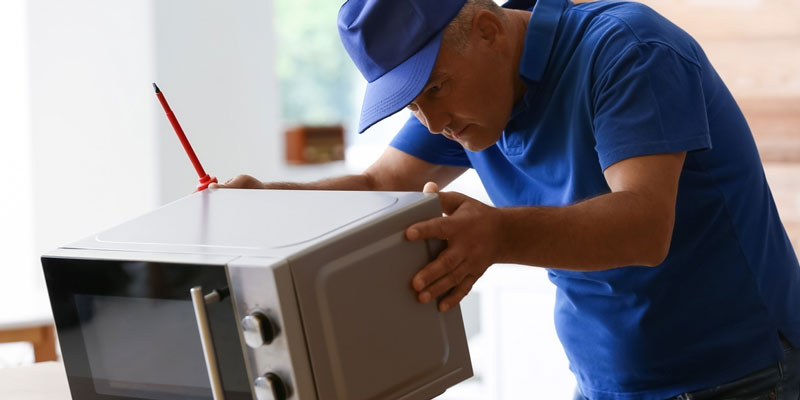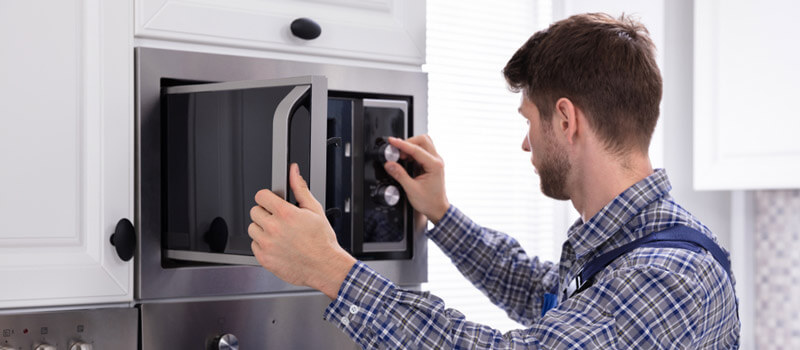In this fast-paced world, it’s hard to deny the indispensability of the microwave. When you need to whip up a quick snack or meal, it comes rushing to the rescue.

Generally, this device does its job and can be relied on to meet your strangely-timed demands. However, there are a few times when you notice some strange noise from the gadget. And, this leaves us confused and asking, “why is my microwave making popping noises?”
Here is the common cause of your microwave making an annoying sound 一 high-fat food being cooked inside, a defective diode, a damaged magnetron, or an empty microwave.
Figuring out the issue is just as easy as solving the problem. Read on to find out more about the causes and ways to fix these unusual sounds on your own.
What Could Cause The Microwave To Make A Popping Noise?
In most cases, a microwave making a popping noise is not a sign that it needs a replacement or a trip to your technician. A couple of things result in the unusual noise, and the machine being faulty isn’t one of them.

Usually, whatever you are cooking in the microwave is boiling, and steam is being spat out. Hence, if your gadget is always making popping noises while cooking, then it’s probably because of the cooking oils or sprays inside.
If you’re not already aware, cooking sprays can create a mess and lead to fire hazards. For these reasons, it’s not ideal to use cooking sprays in a microwave oven. This appliance is built for cooking meals in an instant, not to spray butter or cooking oils.
Other reasons for unusual noise from your microwave could be the metal between the oven rack or cabinet surface and the door. The best way to avoid this issue is to always line the oven rack with aluminum foil or parchment paper to prevent damage or scratches to the cabinet surface.
Furthermore, the popping noise could result from malfunctioning or damaged microwave parts. For instance, a burnt diode or magnetron tends to generate similar noise. If this is the case, it’s paramount that you fix this burn part swiftly to prevent any potential danger to the user and the appliance.
Potential Causes Of The Popping Noise
Faulty Magnetron
A magnetron produces high-frequency EM waves to cook your food quickly. So, when the device is running on a low setting, the magnetron is likely switching on and off for low-frequency generation.
So, if the microwave makes sounds like a magnetron but is way over normal, then it’s likely that the diode or magnetron is faulty. A burnt magnetron results in an irritating high-pitched sound signaling that the magnetron tube has failed, probably due to heavy usage and age.
For a further diagnosis, to be sure it’s the magnetron to be blamed here, you should set the microwave at a low setting to see if the noise stops or reduces as it switches on and off while cooking. Also, if you notice a burning smell, it’s likely the magnetron has gone bad.
Faulty High Voltage Diode
Every microwave oven has a high-voltage circuit containing a capacitor, magnetron, and diode. The responsibility of the diode is to generate direct current from the input AC to power the magnetron. So, when the diode is faulty, it tends to make a loud humming noise.
Faulty Cooling Fan
Another reason your microwave makes a popping noise is likely because the cooling fan is dislodged. Hence, the cooling fan parts tend to clip against the one responsible for that rattling sound.
In addition, the cooling fan motor wears out with time and might need a replacement when you start noticing a louder fan noise. It’s normal for a cooling fan to make a little noise when operating. But when the noise is becoming unbearing, and it’s coming from the rear of your appliance, replacing the motor might be a great idea.
Faulty Turntable Motor
Another culprit might be the turntable motor. If it has gone bad, it’s typically to heat some grinding or clicking sound. The motor is one of the few moving parts of this appliance. It’s responsible for rotating the glass tray to guarantee your food is evenly heated.
Over time, it’s normal for the motor bearings to wear out, creating that screeching or grinding sound as it tries to rotate your food forcefully. In this case, it’s best to replace the turntable motor.
For most microwave ovens, it can be accessed from the bottom panel without having to remove the casing.
Faulty Stirrer Motor
Every microwave has a metal blade powered by a stirrer motor for deflecting the microwave energy uniformly throughout the appliance. This way, your food gets cooked evenly.
So, if the stirrer motor is to be blamed, you’d notice a grinding sound, and your meals will less likely to be evenly cooked.
Is the Popping Noise Harmful?
If your microwave makes a popping noise because you are cooking food high in fat, then this should not cause you to panic. It’s similar to frying any oil or fat-based food on a conventional cooktop with oil popping and shooting everywhere when overheating.

On the other hand, a microwave is an electrical appliance with moving parts, which means it’s subjected to wear and tear that will likely result in a cacophony of hums and rattles. It’s best not to ignore these warning signs. Get to the root of the matter and fix the problem.
In the next section, we’ll discuss practical solutions to microwaves making popping noises:
How to Fix a Popping Microwave Quick Guide
Fixing a burnt/bad magnetron
- Unplug the appliance from the power outlet
- Remove the microwave’s top casing to access the high-voltage circuit and the magnetron
- Discharge the capacitor completely
- Test the magnetron with a multimeter for continuity. You should have read not up to one ohm.
- If the magnetron is defective, remove it carefully and replace it.
Fixing a faulty high-voltage diode
- Make sure the appliance is not plugged into a power source
- Remove the microwave’s top casing to access the high-voltage circuit and the diode
- Discharge the capacitor completely
- Test the high-voltage diode resistance with a multimeter. If it reads between 50k – 200k ohms, then it’s a healthy one.
- Use a multimeter to test the diode for resistance. Depending on the model, a healthy diode will read between 50,000 and 200,000 ohms.
- Next, reverse the leads to determine if there’s continuity in the other direction. There shouldn’t be continuity in both directions.
- If the high voltage diode is to be blamed, then replacing it solves the problem
Fixing a faulty/dislodged cooling fan
- Ensure the appliance is not plugged into a power source
- Discharge the capacitor completely
- For some models, you might have to remove some components to access the cooling fans.
- Check if the fan is spinning freely. If not, you might have to get rid of the debris obstructing it from spinning freely.
- Else, you might have to remove and replace the cooling fan motor.
- Also, you might want to test the motor using a multimeter for continuity. A functional cooling fan motor should measure about 280 ohms.
- Keep in mind that this depends on the model.
- If the cooling fan is the culprit, it’s best to replace the cooling fan motor.
Fixing a bad turntable motor
- Ensure the appliance is not plugged into a power source
- To access the turntable motor, remove the support roller and glass plate from the microwave
- Unscrew the turntable motor panel
- Check the continuity of the turntable motor with a multimeter.
- If there’s none, it’s best to replace the turntable motor
Fixing the stirrer motor
- Make sure the microwave is unplugged from the power source.
- The stirrer motor is located above the turntable plate, which you can access from the microwave cavity.
- Remove the motor’s cover.
- Check if the stirrer blade is in good condition and tightly fixed. Or, remove the stirrer motor and see if the microwave stops making noise.
- If it’s the stirrer motor to be blamed, replace it
Conclusion
Sometimes, switching off your microwave oven and cleaning it properly solves the popping noise. If a good cleaning doesn’t work, you should figure out the faulty part of the microwave 一 remove, repair, or replace it.
In some cases, cleaning the cooking fan eliminates this annoying sound. Nonetheless, you might want to call your professional contractor to help out. Although, if you are handy, you can use a multimeter to test the continuity of these components and replace the faulty parts yourself.
It’s not dangerous if you know what you’re doing and carefully follow the process highlighted in this guide. Now that you know what’s best for you and your microwave, you should be able to make informed decisions.
Related Resources:
